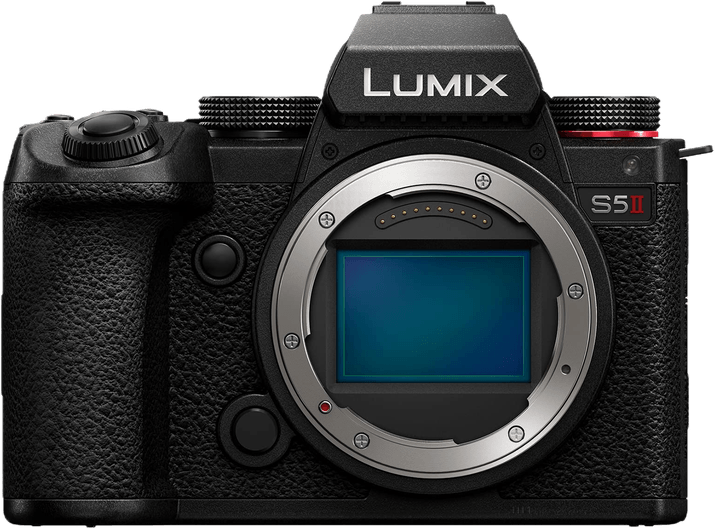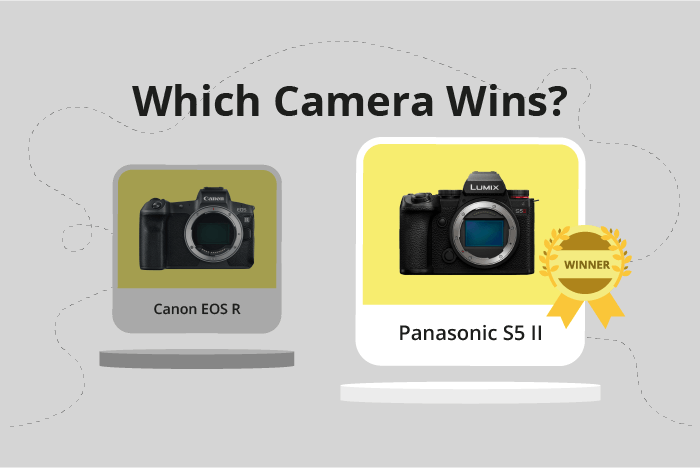Canon EOS R vs Panasonic Lumix S5 II Comparison
Canon EOS R

Panasonic Lumix DC-S5 II

The Panasonic Lumix S5 II edges out the Canon EOS R with a score of 76/100 compared to 74/100. Both are mirrorless cameras and share similar dimensions, with the Lumix S5 II measuring 134 x 102 x 90mm and the EOS R at 136 x 98 x 84mm. The Lumix S5 II is the better camera, boasting a lower launch price of $1999.99 compared to the EOS R’s $2300.
Despite being heavier at 740g (1.63lbs) compared to the EOS R’s 485g (1.07lbs), the Lumix S5 II’s higher score signifies its superior overall performance. The EOS R, released in 2018, does have the advantage of being lighter, but its lower score reveals its limitations when compared to the more recent Lumix S5 II from 2023.
In the end, the Panasonic Lumix S5 II proves to be the better choice for its improved performance and affordable price, while the Canon EOS R still offers a lighter and more compact option for those who prioritize portability.
Canon EOS R vs Panasonic Lumix S5 II Overview and Optics
The Canon EOS R and Panasonic Lumix S5 II both receive an optics score of 73/100 in our comparison. Despite having the same score, each camera has its strengths and weaknesses in terms of optics.
Both cameras share several specifications, including a CMOS sensor, full-frame sensor size, and the same optics score. However, there are notable differences between the two. The Canon EOS R boasts 30.3 megapixels, a Digic 8 processor, and a DXOMARK sensor score of 89. On the other hand, the Panasonic Lumix S5 II has 24 megapixels, an unspecified processor, and a DXOMARK sensor score of 72.
The Canon EOS R outperforms the Panasonic Lumix S5 II in terms of image quality, thanks to its higher megapixel count and superior DXOMARK sensor score. The Digic 8 processor also provides faster image processing and better overall performance.
The Panasonic Lumix S5 II has a slight advantage in shooting speed, with 9 frames per second compared to the Canon EOS R’s 8 frames per second. Additionally, the Lumix S5 II features image stabilization, which the EOS R lacks. This can be particularly useful for photographers who shoot handheld or in low-light situations.
To conclude, the Canon EOS R offers better image quality due to its higher megapixel count and superior sensor score. The Panasonic Lumix S5 II, however, provides faster shooting speed and image stabilization, making it a more versatile option for certain shooting situations. Both cameras are strong contenders, and the choice will ultimately depend on the specific needs and preferences of the photographer.
Canon EOS R vs Panasonic Lumix S5 II Video Performance
The Panasonic Lumix S5 II outperforms the Canon EOS R in video capabilities, scoring 96/100 compared to the Canon’s 70/100. Both cameras share some common features, such as having built-in time-lapse functionality and 4K video resolution. However, the Lumix S5 II offers superior video quality and performance.
The Lumix S5 II surpasses the Canon EOS R with its 6K maximum video resolution and larger video dimensions of 5952 x 3968 pixels. This results in sharper, more detailed footage when compared to the EOS R’s 4K and 3840 x 2160-pixel resolution. Furthermore, the Lumix S5 II boasts a maximum video frame rate of 120fps, quadruple the EOS R’s 30fps. This higher frame rate allows for smoother slow-motion video capture and greater flexibility in post-production editing.
Although the Canon EOS R falls short in comparison to the Lumix S5 II in terms of video resolution and frame rate, it still offers solid video performance for its price range. The 4K resolution and 30fps frame rate are sufficient for most casual videographers and those seeking an entry-level camera with decent video capabilities.
When comparing the video capabilities of both cameras, it is clear that the Panasonic Lumix S5 II is the superior choice for those prioritizing video quality and performance. Its 6K resolution, larger video dimensions, and higher frame rate provide a significant advantage over the Canon EOS R. Nevertheless, the EOS R remains a viable option for those seeking a more affordable camera with adequate video capabilities.
Canon EOS R vs Panasonic Lumix S5 II Features and Benefits
The Canon EOS R wins in the features comparison with a score of 87/100, while the Panasonic Lumix S5 II scores 85/100. Both cameras share several specifications, including a touchscreen, flip screen, WIFI, and Bluetooth connectivity. However, neither camera has GPS functionality.
The Canon EOS R outperforms the Panasonic Lumix S5 II in screen size, offering a larger 3.2-inch screen compared to the 3-inch screen of the Lumix S5 II. This larger screen provides a more comfortable viewing experience for users when composing shots or reviewing images.
On the other hand, the Panasonic Lumix S5 II boasts a higher screen resolution of 2,360,000 dots, compared to the 2,100,000 dots found on the Canon EOS R. This higher resolution results in a sharper and clearer image display, allowing for more precise focus and better image review.
Despite the higher screen resolution of the Lumix S5 II, the Canon EOS R’s overall feature score is higher, making it the better choice for those who prioritize a camera’s features. The larger screen size and similar connectivity options make the EOS R a more user-friendly option.
However, the Panasonic Lumix S5 II should not be disregarded entirely, as its higher screen resolution can be advantageous for photographers who require a sharper display for accurate focus and image review. Ultimately, the choice between these two cameras will depend on the individual’s preferences and requirements, with the Canon EOS R offering a better overall feature set and the Panasonic Lumix S5 II providing a higher resolution display.
Canon EOS R vs Panasonic Lumix S5 II Storage and Battery
The Panasonic Lumix S5 II outperforms the Canon EOS R in storage and battery with a score of 68/100 compared to the EOS R’s 35/100. Both cameras accept SD, SDHC, and SDXC memory cards and offer USB charging. They also have the same battery life of 370 shots.
The Lumix S5 II takes the lead with its two memory card slots, providing more storage options and backup capabilities. This advantage makes it more suitable for professional use where ample storage and data redundancy are crucial.
The Canon EOS R, on the other hand, only has one memory card slot. However, it supports UHS-II compatibility, which allows for faster data transfer rates. This feature may be beneficial for photographers who require quicker file transfers.
Considering these factors, the Lumix S5 II proves to be a more versatile option in terms of storage and battery. The Canon EOS R offers an advantage with its UHS-II compatibility, but it may not be enough to outweigh the benefits of the Lumix S5 II’s dual memory card slots.
Canon EOS R vs Panasonic Lumix S5 II – Our Verdict
Are you still undecided about which camera is right for you? Have a look at these popular comparisons that feature the Canon EOS R or the Panasonic Lumix S5 II:

